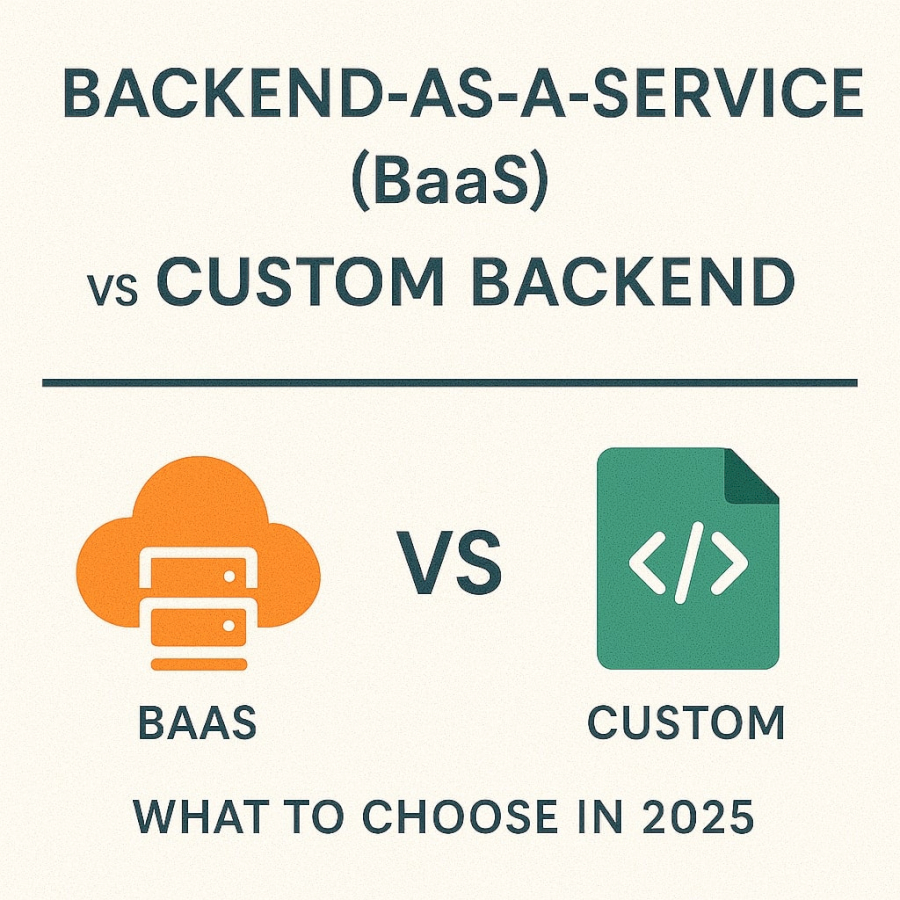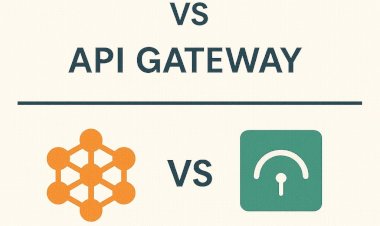Backend-as-a-Service (BaaS) vs Custom Backend: What to Choose in 2025
24 May 2025
The backend architecture decision has become increasingly complex as businesses seek to balance rapid development, scalability, and cost-effectiveness. With the maturation of Backend-as-a-Service (BaaS) platforms and the evolution of custom backend development tools, choosing the right approach for your project in 2025 requires careful consideration of multiple factors.
This comprehensive guide examines Backend-as-a-Service versus custom backend solutions, analyzing their strengths, limitations, costs, and ideal use cases to help you make an informed decision for your next project.
Understanding Backend-as-a-Service (BaaS)
Backend-as-a-Service, also known as Mobile Backend-as-a-Service (MBaaS), provides pre-built backend infrastructure and services that developers can integrate directly into their applications. BaaS platforms handle server management, database operations, user authentication, file storage, and other common backend functionalities without requiring custom server-side code.
Modern BaaS solutions have evolved far beyond their mobile-centric origins to support web applications, IoT devices, and complex enterprise systems. Leading platforms like Firebase, AWS Amplify, Supabase, and Appwrite offer comprehensive backend services with minimal setup requirements.
The core value proposition of BaaS lies in abstracting away infrastructure complexity while providing scalable, managed services that reduce development time and operational overhead. This approach enables developers to focus on frontend development and business logic rather than backend infrastructure concerns.
The Custom Backend Approach
Custom backend development involves building server-side infrastructure from scratch using frameworks like Node.js, Django, Ruby on Rails, or .NET. This approach provides complete control over architecture, data models, business logic, and integration patterns while requiring significant development and operational expertise.
Custom backends offer unlimited flexibility in implementing business requirements, integrating with existing systems, and optimizing performance for specific use cases. However, this flexibility comes with increased complexity, longer development cycles, and ongoing maintenance responsibilities.
The custom backend approach remains popular for complex applications, enterprise systems, and scenarios where specific requirements cannot be met by existing BaaS platforms. Organizations with strong technical teams often choose custom development to maintain full control over their technology stack.
Comparing Development Speed and Time-to-Market
BaaS Advantages in Rapid Development
Backend-as-a-Service platforms dramatically reduce development time by providing pre-built components for common backend functionalities. Authentication systems, database operations, file storage, and API endpoints can be implemented in hours rather than weeks, enabling faster prototyping and MVP development.
The reduced complexity of BaaS integration allows smaller teams to build sophisticated applications without extensive backend expertise. Real-time features, push notifications, and social authentication can be implemented through simple SDK integrations rather than complex server-side development.
Many BaaS platforms provide visual interfaces and no-code/low-code tools that further accelerate development. These tools enable non-technical team members to contribute to backend configuration and reduce dependency on specialized developers.
Custom Backend Development Timelines
Custom backend development requires significantly more time for initial setup, infrastructure configuration, and feature implementation. Building authentication systems, database schemas, API endpoints, and deployment pipelines from scratch can take weeks or months depending on complexity.
However, custom backends can be optimized for specific use cases and business requirements that may not be efficiently addressed by generic BaaS solutions. This optimization can lead to better long-term performance and user experience despite longer initial development cycles.
The development timeline for custom backends also includes ongoing maintenance, security updates, and infrastructure management that BaaS platforms handle automatically. These operational responsibilities must be factored into long-term project planning and resource allocation.
Cost Analysis and Total Cost of Ownership
BaaS Pricing Models and Scalability
Most BaaS platforms use usage-based pricing models that scale with application growth. While this provides predictable costs for small applications, expenses can increase significantly as user bases and data volumes grow. Understanding pricing tiers and scaling thresholds is crucial for long-term cost planning.
Firebase, for example, offers generous free tiers but costs can escalate quickly with increased database operations, storage usage, and bandwidth consumption. AWS Amplify provides more granular pricing but requires careful monitoring to avoid unexpected charges.
The total cost of ownership for BaaS includes not just platform fees but also potential vendor lock-in costs, data migration expenses, and limitations on customization that might require additional services or tools.
Custom Backend Cost Considerations
Custom backend development involves higher upfront costs for development, infrastructure setup, and team scaling. Server hosting, database management, security implementation, and ongoing maintenance represent significant ongoing expenses.
However, custom backends can be more cost-effective at scale, especially for applications with predictable usage patterns or specific optimization requirements. Organizations can choose cost-effective hosting solutions and optimize resource usage based on actual needs rather than platform limitations.
The hidden costs of custom backend development include security audits, compliance requirements, disaster recovery planning, and technical debt management. These expenses often increase over time and require dedicated resources to manage effectively.
Scalability and Performance Comparison
BaaS Scalability Characteristics
Backend-as-a-Service platforms are designed for automatic scaling, handling traffic spikes and growth without manual intervention. Cloud-native architectures and managed infrastructure ensure applications can scale from hundreds to millions of users with minimal configuration changes.
However, BaaS scalability comes with platform-specific limitations and constraints. Database query patterns, API rate limits, and storage architectures are predetermined by platform design, potentially creating bottlenecks for specific use cases.
Performance optimization in BaaS environments requires working within platform constraints rather than implementing custom solutions. While this simplifies operations, it may limit performance tuning options for applications with specific requirements.
Custom Backend Performance Optimization
Custom backends offer unlimited performance optimization opportunities through architecture choices, database design, caching strategies, and server configurations. Applications can be fine-tuned for specific use cases, geographic regions, and performance requirements.
The flexibility of custom backends enables implementation of advanced performance features like custom caching layers, database sharding, microservices architectures, and specialized data structures. These optimizations can provide significant performance advantages for complex applications.
However, achieving optimal performance with custom backends requires significant expertise in system architecture, database optimization, and infrastructure management. The responsibility for monitoring, tuning, and maintaining performance lies entirely with the development team.
Security and Compliance Considerations
BaaS Security Features
Leading BaaS platforms provide enterprise-grade security features including encryption at rest and in transit, regular security audits, compliance certifications, and automatic security updates. These features are often more comprehensive than what small teams could implement independently.
Authentication and authorization systems in BaaS platforms are battle-tested and regularly updated to address emerging security threats. Integration with identity providers, multi-factor authentication, and role-based access control are typically included without additional development effort.
However, security in BaaS environments requires trusting third-party platforms with sensitive data and accepting their security models. Some organizations, particularly in regulated industries, may require more granular security controls than BaaS platforms provide.
Custom Backend Security Implementation
Custom backends provide complete control over security implementation, enabling compliance with specific regulatory requirements and organizational security policies. Custom encryption, audit logging, and access controls can be implemented based on exact business needs.
The flexibility of custom security implementation is particularly valuable for enterprise applications, financial services, healthcare systems, and other regulated industries with strict security requirements that may not be fully addressed by generic BaaS solutions.
However, custom security implementation requires significant expertise and ongoing attention to emerging threats, vulnerability management, and compliance requirements. Security mistakes in custom backends can have severe consequences and are entirely the responsibility of the development team.
Popular BaaS Platforms in 2025
Firebase: Google's Comprehensive Platform
Firebase remains the most popular BaaS platform, offering real-time databases, authentication, hosting, cloud functions, and analytics in a cohesive ecosystem. The platform excels in rapid prototyping, real-time applications, and mobile development with excellent SDK support across platforms.
Firebase's strength lies in its integrated ecosystem and ease of use, making it ideal for startups, small to medium applications, and teams seeking rapid development cycles. The platform's real-time capabilities and offline synchronization features are particularly valuable for collaborative applications.
Limitations include vendor lock-in concerns, pricing scalability challenges, and limited customization options for complex business logic. Large applications may encounter performance bottlenecks and cost escalation as usage grows.
AWS Amplify: Enterprise-Grade BaaS
AWS Amplify provides a comprehensive BaaS solution built on Amazon Web Services infrastructure, offering superior scalability, enterprise features, and integration with the broader AWS ecosystem. The platform supports complex applications with advanced features like GraphQL APIs, machine learning integration, and multi-environment deployments.
Amplify's strength lies in its enterprise readiness, extensive customization options, and seamless integration with AWS services. Organizations already using AWS infrastructure can leverage existing investments and expertise while adopting BaaS benefits.
The platform's complexity and learning curve can be challenging for smaller teams, and costs can escalate quickly without proper monitoring and optimization. The extensive feature set may be overwhelming for simple applications.
Supabase: Open Source Alternative
Supabase positions itself as an open-source Firebase alternative, providing PostgreSQL databases, real-time subscriptions, authentication, and storage with greater transparency and flexibility than proprietary platforms. The open-source approach addresses vendor lock-in concerns while maintaining BaaS convenience.
The platform's PostgreSQL foundation provides familiar database features, complex queries, and mature ecosystem tools. Self-hosting options enable organizations to maintain control over their data while benefiting from BaaS development speed.
Supabase is newer than established platforms and may lack some enterprise features and ecosystem maturity. The platform's open-source nature requires more technical expertise for advanced configurations and optimizations.
Appwrite: Developer-Focused Platform
Appwrite focuses on developer experience with comprehensive SDKs, detailed documentation, and self-hosted deployment options. The platform provides authentication, databases, storage, and cloud functions with emphasis on privacy and data ownership.
The platform's self-hosting capabilities appeal to organizations with strict data residency requirements or those seeking to avoid vendor lock-in while maintaining BaaS development benefits. Docker-based deployment simplifies infrastructure management.
As a newer platform, Appwrite has a smaller ecosystem and community compared to established alternatives. Feature completeness and enterprise readiness may be limited compared to mature platforms.
Custom Backend Technology Stacks
Node.js and Express Ecosystem
Node.js remains popular for custom backend development due to JavaScript's ubiquity, extensive npm ecosystem, and excellent performance for I/O-intensive applications. Frameworks like Express, Koa, and Fastify provide minimal overhead while enabling rapid API development.
The Node.js ecosystem includes mature tools for database integration, authentication, testing, and deployment. TypeScript adoption has addressed traditional JavaScript concerns while maintaining development speed and ecosystem compatibility.
Event-driven architecture and non-blocking I/O make Node.js particularly suitable for real-time applications, microservices, and API-heavy backends. However, CPU-intensive operations may require additional architectural considerations.
Python and Django/FastAPI
Python's popularity in backend development continues growing, driven by frameworks like Django and FastAPI that provide different approaches to web application development. Django offers comprehensive features for rapid development, while FastAPI provides modern async capabilities and automatic API documentation.
Python's strength lies in its extensive ecosystem, machine learning integration capabilities, and readable syntax that enhances team productivity. The language's versatility enables seamless integration with data science workflows and AI/ML services.
Performance considerations may require careful optimization for high-throughput applications, though modern Python frameworks and async capabilities address many traditional limitations.
Go and Microservices Architecture
Go has gained significant traction for backend development due to excellent performance, built-in concurrency support, and deployment simplicity. The language's characteristics make it particularly suitable for microservices, API development, and high-performance applications.
Go's compilation to native binaries simplifies deployment and reduces operational overhead compared to interpreted languages. The language's standard library includes robust HTTP, JSON, and networking capabilities without external dependencies.
The Go ecosystem, while growing rapidly, may lack some specialized libraries and tools available in more established ecosystems. Team expertise and hiring considerations may also influence adoption decisions.
Decision Framework for 2025
Project Requirements Analysis
Begin by thoroughly analyzing project requirements including expected user base, performance needs, compliance requirements, and integration complexity. Simple applications with standard features align well with BaaS capabilities, while complex business logic may require custom development.
Evaluate time-to-market requirements against long-term scalability needs. BaaS platforms excel for rapid prototyping and MVP development, while custom backends provide better long-term flexibility and optimization opportunities.
Consider regulatory and compliance requirements that may mandate specific security controls, data residency, or audit capabilities. Some industries may require custom backend development to meet stringent regulatory requirements.
Team Expertise and Resources
Assess your team's backend development expertise, operational capabilities, and long-term resource availability. BaaS platforms reduce backend expertise requirements but may limit customization and optimization opportunities.
Consider hiring and scaling implications of each approach. BaaS adoption may reduce backend developer requirements but could increase dependency on platform-specific expertise. Custom backend development requires ongoing investment in backend expertise and operational capabilities.
Evaluate organizational preferences for control versus convenience. Some organizations prioritize maintaining complete control over their technology stack, while others prefer managed services that reduce operational overhead.
Budget and Timeline Constraints
Analyze total cost of ownership including development costs, operational expenses, and scaling implications. BaaS platforms may provide cost advantages for smaller applications but can become expensive at scale.
Consider opportunity costs of custom backend development including delayed time-to-market and resource allocation to infrastructure concerns rather than core business features.
Evaluate long-term budget implications including potential vendor lock-in costs, migration expenses, and scaling limitations that might require architecture changes.
Hybrid Approaches and Best Practices
Combining BaaS and Custom Components
Many successful applications adopt hybrid approaches that combine BaaS services for common functionalities with custom backend components for specialized requirements. This approach maximizes development speed while maintaining flexibility for unique business logic.
Use BaaS platforms for standardized features like authentication, file storage, and push notifications while implementing custom APIs for complex business logic, data processing, or integration requirements.
This hybrid approach enables teams to benefit from BaaS convenience while maintaining control over critical business components. However, it requires careful architecture planning to ensure smooth integration between BaaS and custom components.
Migration Strategies
Plan for potential migration scenarios from BaaS to custom backends or between different BaaS platforms. Design data models and API structures that minimize migration complexity and maintain portability.
Implement abstraction layers that isolate BaaS-specific implementations from core business logic. This approach simplifies future migration decisions and reduces vendor lock-in risks.
Consider gradual migration strategies that enable incremental movement from BaaS to custom solutions as requirements evolve and resources become available.
Future Trends and Considerations
Edge Computing and Distributed Backends
The growth of edge computing is influencing backend architecture decisions, with increasing demand for distributed backends that can operate across multiple geographic regions and edge locations. BaaS platforms are beginning to incorporate edge capabilities, while custom backends require careful architecture for distributed deployment.
Edge computing requirements may favor custom backend approaches that can be optimized for specific geographic and latency requirements. However, BaaS platforms are rapidly adding edge capabilities to remain competitive.
AI and Machine Learning Integration
The integration of AI and machine learning capabilities into applications is driving demand for backends that can efficiently handle model inference, training data management, and real-time predictions. BaaS platforms are adding AI services, while custom backends enable specialized ML infrastructure.
Consider the AI/ML requirements of your application when choosing between BaaS and custom approaches. BaaS platforms may provide convenient AI services for common use cases, while custom backends enable specialized ML architectures and model deployment strategies.
Serverless and Function-as-a-Service Evolution
The evolution of serverless computing and Function-as-a-Service (FaaS) platforms is blurring the lines between BaaS and custom backend development. Modern serverless platforms enable custom business logic deployment without traditional server management overhead.
This trend may influence the BaaS versus custom backend decision by providing middle-ground options that combine custom development flexibility with managed infrastructure benefits.
Making the Right Choice for Your Project
When to Choose BaaS
Select Backend-as-a-Service when rapid development and time-to-market are priorities, team expertise in backend development is limited, or project requirements align well with platform capabilities. BaaS is particularly suitable for startups, MVPs, and applications with standard feature requirements.
Consider BaaS for projects with predictable scaling patterns, limited customization requirements, and teams that prefer focusing on frontend development and user experience rather than backend infrastructure.
BaaS platforms excel for real-time applications, mobile backends, and scenarios where development speed outweighs customization flexibility.
When to Choose Custom Backend
Choose custom backend development when you have specific requirements that cannot be met by BaaS platforms, need complete control over architecture and data, or have compliance requirements that mandate custom security implementations.
Custom backends are ideal for complex business logic, enterprise applications, systems requiring extensive third-party integrations, or scenarios where long-term cost optimization is critical.
Consider custom development when your team has strong backend expertise, operational capabilities, and the resources to maintain and scale infrastructure over time.
Hybrid Strategy Benefits
Implement hybrid approaches when you need the rapid development benefits of BaaS for standard features while maintaining flexibility for specialized requirements. This strategy enables gradual evolution from BaaS to custom solutions as needs change.
Hybrid approaches work well for organizations with mixed expertise levels, varying project requirements, or those seeking to minimize vendor lock-in while maximizing development efficiency.
Conclusion
The choice between Backend-as-a-Service and custom backend development in 2025 depends on a complex interplay of factors including project requirements, team expertise, budget constraints, and long-term strategic goals. Neither approach is universally superior; success depends on matching the right solution to specific project needs.
BaaS platforms have matured significantly and now offer enterprise-grade capabilities that can support complex applications while maintaining development speed advantages. However, custom backend development remains necessary for applications with specialized requirements, complex business logic, or strict compliance needs.
The hybrid approach is increasingly popular, enabling organizations to benefit from BaaS convenience for standard features while maintaining custom development for specialized requirements. This strategy provides flexibility while minimizing vendor lock-in risks.
As you evaluate options for your 2025 projects, consider not just immediate requirements but also long-term scalability, team capabilities, and strategic technology goals. The best choice is the one that aligns with your specific context, constraints, and objectives while providing a solid foundation for future growth and evolution.
The backend landscape will continue evolving with new platforms, tools, and approaches emerging regularly. Stay informed about developments in both BaaS and custom backend technologies to make informed decisions that serve your organization's long-term interests.

